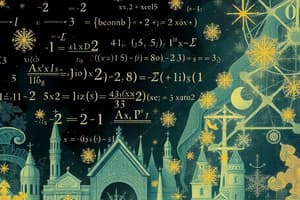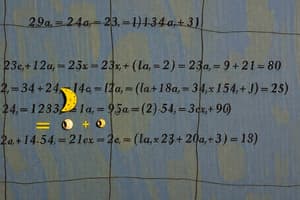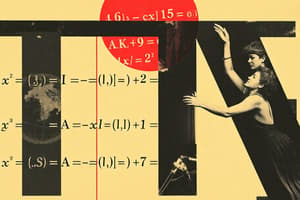Podcast
Questions and Answers
Which of the following statements accurately describes the relationship between coefficients and variables in an algebraic term?
Which of the following statements accurately describes the relationship between coefficients and variables in an algebraic term?
- The coefficient and variable are added together to form the term.
- The coefficient is the variable itself, while the variable scales the numerical value of the term.
- The coefficient is an exponent that raises the variable to a certain power.
- The coefficient is a numerical factor that multiplies the variable, scaling its value. (correct)
Consider the equation $3x + 5 = 2(x - 1)$. What is the correct first step in solving for $x$?
Consider the equation $3x + 5 = 2(x - 1)$. What is the correct first step in solving for $x$?
- Combine $3x$ and $5$ on the left side of the equation.
- Apply the distributive property on the right side of the equation. (correct)
- Divide both sides of the equation by 3.
- Subtract 5 from both sides of the equation.
What is the primary goal when solving a system of linear equations?
What is the primary goal when solving a system of linear equations?
- To find any values for the variables that satisfy at least one of the equations.
- To graph the equations and find the y-intercepts.
- To find a set of values for the variables that satisfy all equations simultaneously. (correct)
- To eliminate all variables from the system.
When solving an inequality, under what condition is it necessary to reverse the inequality sign?
When solving an inequality, under what condition is it necessary to reverse the inequality sign?
Given $f(x) = 2x^2 - 3x + 1$, what does $f(a + 1)$ represent?
Given $f(x) = 2x^2 - 3x + 1$, what does $f(a + 1)$ represent?
What distinguishes a trinomial from other types of polynomials?
What distinguishes a trinomial from other types of polynomials?
Simplify the expression: $(x^2y^3)^2 * x^{-1}y$
Simplify the expression: $(x^2y^3)^2 * x^{-1}y$
Which expression is equivalent to $\sqrt[3]{a^6b^9}$?
Which expression is equivalent to $\sqrt[3]{a^6b^9}$?
If $\log_b(x) = 3$ and $\log_b(y) = 2$, what is $\log_b(x^2/y)$?
If $\log_b(x) = 3$ and $\log_b(y) = 2$, what is $\log_b(x^2/y)$?
What is the primary difference between solving a linear equation and solving an exponential equation?
What is the primary difference between solving a linear equation and solving an exponential equation?
Flashcards
What are variables in algebra?
What are variables in algebra?
Symbols that represent quantities without fixed values.
What are constants?
What are constants?
Fixed numerical values that do not change.
What are algebraic expressions?
What are algebraic expressions?
Mathematical phrases containing numbers, variables, and operation symbols (e.g., 3x + 2y).
What are terms in an expression?
What are terms in an expression?
Signup and view all the flashcards
What is a coefficient?
What is a coefficient?
Signup and view all the flashcards
What are like terms?
What are like terms?
Signup and view all the flashcards
What does it mean to evaluate an expression?
What does it mean to evaluate an expression?
Signup and view all the flashcards
What are equations?
What are equations?
Signup and view all the flashcards
What does it mean to solve an equation?
What does it mean to solve an equation?
Signup and view all the flashcards
What are inverse operations?
What are inverse operations?
Signup and view all the flashcards
Study Notes
- Algebra involves symbols and rules to manipulate them.
- Symbols represent quantities without fixed values, known as variables.
- Algebra is a unifying branch of nearly all mathematics.
Basic Operations
- Addition, subtraction, multiplication, and division are the fundamental operations.
- These operations apply to numerical values and variables.
Variables and Constants
- Variables are symbols (usually letters) representing unknown or changeable values.
- Constants are fixed numerical values that remain unchanged.
- Expressions are combinations of variables, constants, and operations.
- Equations declare the equality of two expressions.
Algebraic Expressions
- Algebraic expressions are mathematical phrases containing numbers, variables, and operation symbols.
- Examples of algebraic expressions include 3x + 2y, a - 5, and x^2 + 4x - 7.
- Terms are parts of an algebraic expression separated by addition or subtraction; in "3x + 2y", "3x" and "2y" are terms.
- Coefficients are the numerical part of a term containing a variable; in "3x", 3 is the coefficient.
- Like terms share the same variable raised to the same power and can be combined (e.g., 3x + 5x = 8x).
- Unlike terms have different variables or the same variables raised to different powers and cannot be combined directly.
Evaluating Expressions
- Evaluating an expression means finding its numerical value by substituting specific values for the variables.
- The order of operations (PEMDAS/BODMAS) is vital when evaluating expressions.
Equations and Solving Equations
- Equations state the equality of two expressions, connected by an equals sign (=).
- Solving an equation means finding the value(s) of the variable(s) that satisfy the equation.
- A solution is the value(s) that satisfy the equation.
- Linear equations contain variables raised to the first power only.
- Quadratic equations contain variables raised to the second power.
Techniques for Solving Equations
- Isolation involves isolating the variable on one side of the equation by performing the same operations on both sides.
- Inverse operations use opposite operations to undo operations affecting the variable (e.g., using subtraction to undo addition).
- Combining like terms simplifies each side of the equation.
- Distributive property: a(b + c) = ab + ac; apply it to remove parentheses.
- Factoring expresses a quadratic expression as the product of two linear expressions and is used to solve quadratic equations.
- Quadratic Formula: x = (-b ± √(b^2 - 4ac)) / (2a); used to solve quadratic equations of the form ax^2 + bx + c = 0.
Linear Equations
- A linear equation can be written in the form ax + b = 0, where a and b are constants, and x is the variable.
- Solving linear equations involves isolating the variable on one side of the equation.
- Examples of linear equations include 2x + 3 = 7 and 5x - 1 = 9.
- Use inverse operations to isolate the variable when solving.
Systems of Linear Equations
- A system of linear equations features two or more linear equations with the same variables.
- Solving a system means finding values for the variables that satisfy all equations simultaneously.
- Methods for solving systems of linear equations:
- Substitution: Solve one equation for one variable and substitute that expression into the other equation.
- Elimination: Add or subtract multiples of the equations to eliminate one of the variables.
- Graphing: Graph each equation and find the point(s) of intersection, representing the solution(s).
Inequalities
- Inequalities compare two expressions using symbols like <, >, ≤, and ≥.
- Solving inequalities involves finding the range of values for the variable that make the inequality true.
- Operations are similar to solving equations, but multiplying or dividing by a negative number reverses the inequality sign.
Functions
- A function is a relationship between a set of inputs (domain) and a set of possible outputs (range), where each input is related to exactly one output.
- f(x) represents the output of the function f for an input x.
- Types of functions include:
- Linear Functions: f(x) = mx + b, where m is the slope and b is the y-intercept.
- Quadratic Functions: f(x) = ax^2 + bx + c.
- Polynomial Functions: Functions involving non-negative integer powers of x.
- Exponential Functions: f(x) = a^x, where a is a constant.
- Logarithmic Functions: Inverse of exponential functions.
- Domain: Set of all possible input values (x-values) for a function.
- Range: Set of all possible output values (y-values) for a function.
Polynomials
- Polynomials are expressions with variables and coefficients, involving only addition, subtraction, multiplication, and non-negative integer exponents.
- Standard Form: Polynomials are often written in descending order of exponents.
- Degree is the highest power of the variable.
- Types of Polynomials:
- Monomial: A polynomial with one term (e.g., 5x^2).
- Binomial: A polynomial with two terms (e.g., 3x + 2).
- Trinomial: A polynomial with three terms (e.g., x^2 + 4x - 7).
- Operations with Polynomials:
- Addition/Subtraction: Combine like terms.
- Multiplication: Use the distributive property.
- Division: Polynomial long division or synthetic division.
- Factoring Polynomials:
- Common Factors: Factor out the greatest common factor (GCF).
- Difference of Squares: a^2 - b^2 = (a + b)(a - b).
- Perfect Square Trinomials: a^2 + 2ab + b^2 = (a + b)^2, a^2 - 2ab + b^2 = (a - b)^2.
- Factoring Quadratics: Express a quadratic trinomial as the product of two binomials.
Exponents and Radicals
- Exponents indicate repeated multiplication of a base.
- Laws of Exponents:
- Product of Powers: a^m * a^n = a^(m+n).
- Quotient of Powers: a^m / a^n = a^(m-n).
- Power of a Power: (a^m)^n = a^(mn).
- Power of a Product: (ab)^n = a^n * b^n.
- Power of a Quotient: (a/b)^n = a^n / b^n.
- Negative Exponents: a^(-n) = 1 / a^n.
- Zero Exponent: a^0 = 1 (if a ≠ 0).
- Radicals (roots) are the inverse operation of exponentiation.
- Square Root: √a is the number that, when multiplied by itself, equals a.
- nth Root: ⁿ√a is the number that, when raised to the nth power, equals a.
- Rational Exponents: a^(m/n) = ⁿ√a^m = (ⁿ√a)^m.
- Simplifying Radicals: Remove perfect square factors from under the radical sign.
- Operations with Radicals:
- Addition/Subtraction: Combine like radicals (same radicand).
- Multiplication: Multiply the radicands.
- Division: Divide the radicands.
- Rationalizing the Denominator: Eliminate radicals from the denominator of a fraction.
Logarithms
- Logarithms are the inverse of exponential functions.
- Definition: log_b(x) = y if and only if b^y = x, where b is the base.
- Common Logarithm: Base 10 logarithm (log_10(x) or log(x)).
- Natural Logarithm: Base e logarithm (log_e(x) or ln(x)), where e ≈ 2.71828.
- Properties of Logarithms:
- Product Rule: log_b(mn) = log_b(m) + log_b(n).
- Quotient Rule: log_b(m/n) = log_b(m) - log_b(n).
- Power Rule: log_b(m^p) = p * log_b(m).
- Change of Base Formula: log_a(x) = log_b(x) / log_b(a).
- Solving Logarithmic Equations: Use the properties of logarithms to isolate the variable.
- Solving Exponential Equations: Take the logarithm of both sides to isolate the variable.
Studying That Suits You
Use AI to generate personalized quizzes and flashcards to suit your learning preferences.




